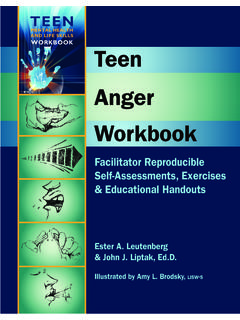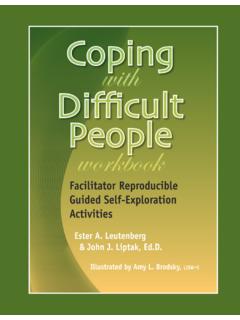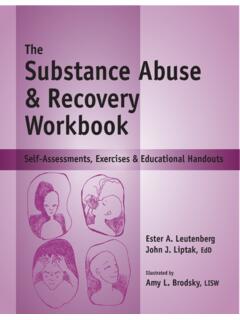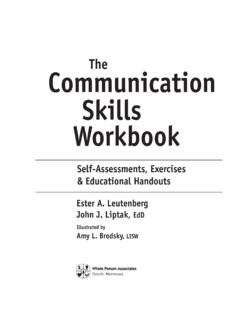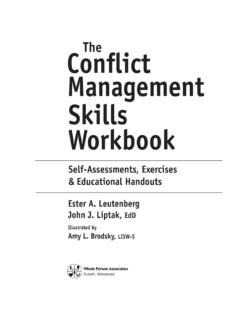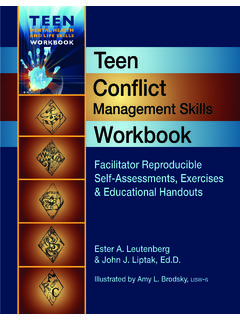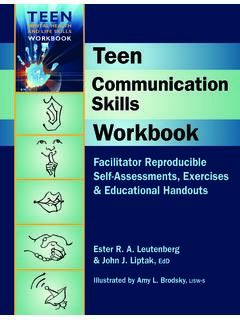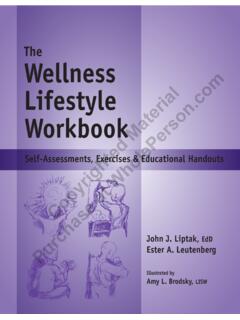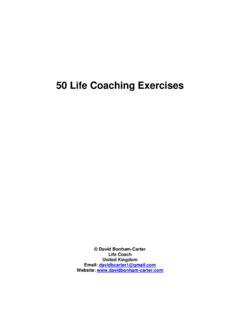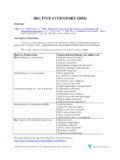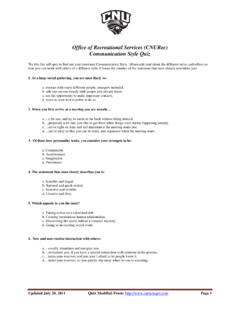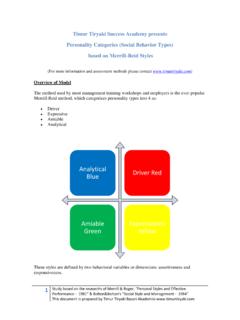Transcription of AND LIFE SKILLS WORKBOOK Teen Self-Esteem Workbook
1 WorkbookFacilitator Reproducible self -Assessments, Exercises & Educational HandoutsJohn J. Liptak, EdD Ester A. Leutenberg Illustrated byAmy L. Brodsky, LISW-STeenDuluth, MinnesotaSelf-EsteemFacilitator Reproducible self -Assessments, Exercises & Educational HandoutsEster A. Leutenberg & John J. Liptak, by Amy L. Brodsky, lisw-s MENTAL HEALTH AND LIFE SKILLS WORKBOOKW orkbookTeenTEENSelf-Esteem101 W. 2nd St., Suite 203 Duluth MN Self-Esteem WORKBOOK Facilitator Reproducible self -Assessments, Exercises & Educational HandoutsCopyright 2011 by Ester A. Leutenberg and John J. Liptak. All rights reserved. Except for short excerpts for review purposes and materials in the assessment, journaling activities, and educational handouts sections, no part of this book may be reproduced or transmitted in any form by any means, electronic or mechanical without permission in writing from the publisher.
2 self -assessments, exercises, and educational handouts are meant to be efforts have been made to ensure accuracy of the information contained in this book as of the date published. The author(s) and the publisher expressly disclaim responsibility for any adverse effects arising from the use or application of the information contained herein. Printed in the United States of America10 9 8 7 6 5 4 3 2 Editorial Director: Carlene Sippola Art Director: Joy Morgan DeyLibrary of Congress Control Number:2011927797 ISBN: 978-1-57025-254-9(Continued on the next page)Using This Book (For the professional)To be able to reach personal and professional goals, Self-Esteem is critical. For teens , healthy Self-Esteem is even more critical, both emotionally and physically. Self-Esteem dictates how teens treat and feel about themselves and others, assert themselves, view and act in the world, and take care of their basic needs.
3 Research suggests that low Self-Esteem can be tied to many mental and physical health issues:The Teen Self-Esteem WORKBOOK is designed to help teens engage in self -reflection, examine their thoughts and feelings that either enhance or detract from healthy Self-Esteem , and learn effective tools and techniques for building positive feelings of Self-Esteem and self -worth. This book combines three powerful psychological tools for the management of aggressive thoughts, feelings and behaviors: self -assessment, journaling and role-playing. All to enhance empathy and allow teens to practice Self-Esteem building strategies. The Teen Self-Esteem WORKBOOK contains five separate sections that will guide the participants toward learning more about themselves and how their Self-Esteem impacts Self-Esteem Scale helps teens explore their perceptions of themselves and feelings about self -Worth Scale helps teens explore the extent to which they view themselves as valuable and worthy human self -Understanding Scale helps teens explore how aware they are of their personal characteristics and self -Responsibility Scale helps teens explore how much responsibility they assume for what happens in their lives.
4 Teen assertiveness Scale helps teens explore how assertive they are in their asking for what they want and : Enrichment Activities in this section. Aches and pains Alcohol abuse Angry outbursts Anxiety Bullying issues (victim, bully, bystander) Depression Drug use Eating disorders Fatigue Loneliness Poor school / work performance Relationships Stress Unhealthy eatingUsing This Book (For the professional, continued)Additional FactorsThe Teen Self-Esteem WORKBOOK deals with many different aspects of Self-Esteem , including self -worth, self -responsibility, self -awareness, and assertive behavior. Self-Esteem is a person s overall evaluation of self -worth and encompasses a person s emotions, thoughts and ways of behaving. For people to make effective decisions and efficiently solve problems, they must have healthy Self-Esteem .
5 teens with healthy Self-Esteem are likely not to simply follow the crowd, but rather to trust themselves to make decisions that are in their best interest. Prior to beginning each section, you may want to use the educational handouts toward the end of the section, as an introduction or review for yourself and / or the Codes for ConfidentialityConfidentiality is a term for any action that preserves the privacy of people. Because teens completing the activities in this WORKBOOK might be asked to answer assessment items and to journal about and explore their relationships, you will need to discuss confidentiality before you begin using the materials in this WORKBOOK . Maintaining confidentiality is important as it shows respect for others and allows participants to explore their feelings without hurting anyone s feelings or fearing gossip, harm or retribution.
6 In order to maintain confidentiality, explain to the participants that they need to assign a code name for each person they write about as they complete the various activities in the WORKBOOK . For example, a friend named Joey who enjoys going to hockey games might be titled JLHG (Joey Loves Hockey Games) for a particular exercise. In order to protect their friends identities, they should not use people s actual names or initials just of the BookThe Teen Self-Esteem WORKBOOK is designed to be used either independently or as part of an integrated curriculum. You may administer one of the assessments and the journaling exercises to an individual or a group with whom you are working, or you may administer a number of the assessments over one or more Pages in the First Five Sections:q Assessment Instruments self -assessment inventories with scoring directions and interpretation materials offer group facilitators to choose one or more of the activities relevant to their participants.
7 Q Activity Handouts Practical questions and activities that prompt self -reflection and promote self -understanding, foster introspection and promote pro-social Quotations Quotations in each section provide insight and promote reflection. Participants will be asked to select one or more of the quotations and journal about what the quotations mean to them. q Reflective Questions for Journaling self -exploration activities and journaling exercises specific to each assessment will enhance self -discovery, learning, and healing. q Educational Handouts Handouts designed to enhance instruction can be used individually or in groups to promote an understanding of the participants Self-Esteem , and tools and techniques for enhancing Self-Esteem . These pages can be distributed, scanned and converted into masters for overheads or transparencies, projected or written on boards and / or discussed.
8 Who Should Use This Program?This book has been designed as a practical tool for helping professionals, such as therapists, counselors, psychologists, teachers, group leaders, etc. Depending on the role of the professional using the Teen Self-Esteem WORKBOOK and the specific group s needs, these sections can be used individually or combined for a more comprehensive approach. Why Use self -Assessments? self -assessments are important in helping teens develop a healthy Self-Esteem . Participants engage in these ways to explore personal elements of Self-Esteem : Become aware of the primary motivators that guide their behavior Explore and learn to let go of troublesome habits and behavioral patterns learned in childhood Explore the effects of unconscious childhood messages Gain insight and a wake-up call for behavioral change Focus thinking on behavioral goals for change Uncover resources they possess that can help them to cope better with problems and difficult choices Explore personal characteristics without judgment Develop awareness of personal strengths and weaknessesBecause the assessments are presented in a straightforward and easy-to-use format, individuals can self -administer, score and interpret each assessment at their own the Assessments, Journaling Activities and Educational HandoutsMaterials in the Assessments.
9 Journaling Activities, and Educational Handouts sections in this book are reproducible and can be photocopied for participants use. Assessments contained in this book focus on self -reported data and thus are similar to ones used by psychologists, counselors, therapists and career consultants. The accuracy and usefulness of the information provided is dependent on the truthful information that each participant provides. By being honest, participants help themselves to learn about unproductive and ineffective patterns in their lives, and to uncover information that might be keeping them from being as happy or as successful as they might be. An assessment instrument can provide participants with valuable information about themselves; however, these assessments cannot measure or identify everything.
10 The assessments purpose is not to pigeonhole certain characteristics, but rather to allow participants to explore all of their characteristics. This book contains self -assessments, not tests. Tests measure knowledge or whether something is right or wrong. For the assessments in this book, there are no right or wrong answers. These assessments ask for personal opinions or attitudes about a topic of importance in the participant s administering the assessments in this WORKBOOK , remember that even though the items are generically written so that they will be applicable to a wide variety of people, all items will not account for every possible variable for every person. No assessments are specifically tailored to one person, so use the assessments to help participants identify negative themes in their lives and to find ways to break the hold of these patterns and their teen participants taking the assessments that they should not spend too much time trying to analyze the content of the questions; they should think about the questions in general and then spontaneously report how they feel about each one.
